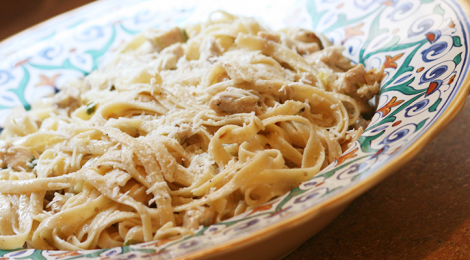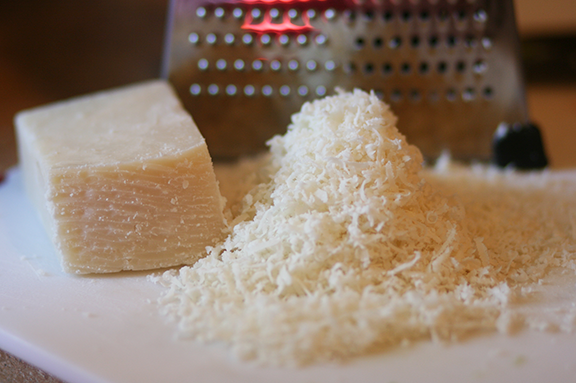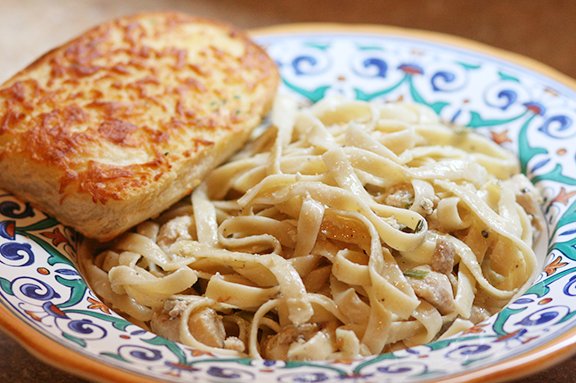
Chicken Alfredo
After having shrimp/seafood alfredo a few times at Italian restaurants, I was sure about one thing: I wanted CHICKEN ALFREDO!!!
My husband offered to take me to a couple of zabiha Italian restaurants, but I decided to try making it myself. It turned out fantastic and is a recipe worth sharing.
I have a few rules of thumb when it comes to Italian cooking. My experience is that Italian food doesn’t usually call for as many spices and ingredients as we do in desi food. I have to admit that I don’t follow their style of cooking, and I cook mostly according to my desi style. But for the few ingredient that a recipe calls for, I always make it a priority to use good quality, fresh ingredients, and I feel that that makes all the difference.
So what is the most key ingredient in Alfredo sauce? Parmigiano-Reggiano. We know it as Parmesan cheese, but Parmigiano-Reggiano is far, far superior to regular Parmesan. Known as the King of Cheeses, and one of the most expensive hard cheeses available today, (the tiny block that I used for this dish cost me upwards of $7- err I hope my husband is not reading this), but making this cheese follows such method, detail and precision that it is considered well worth the cost.
When I was first shopping for Parmigiano-Reggiano, I really wanted to get a good quality block, and when I saw one that said ‘imported,’ I happily deduced that it must be good. What I didn’t know then is that there is a reason that certain Parmesan cheese is called Parmigiano-Reggiano.
The story of Parmigiano-Reggiano started some nine centuries ago, when its process was first perfected. This process has been passed down from generation to generation, and cheese makers follow the exact same method today. After the second World War, Parmigiano-Reggiano producers set up formal rules, guidelines and standards for its production to protect the original production process and maintain its quality for the benefit of both the cheese makers and consumers. As a result, each and every single wheel that is produced undergoes rigorous inspection by experts. Thereafter, it is marked and sold to consumers.
The cheese is made exclusively in its place of origin, in the provinces of Parma, Reggio Emilia, Modena and parts of the provinces of Mantua and Bologna. Only the cheese made here may be known as Parmigiano-Reggiano. So, unless you live in this region, your Parmigiano-Reggiano will always be imported.
Parmigiano-Reggiano is not machine manufactured. Each wheel is made by hand by cheese makers in artisan dairies. They follow strict rules of giving the cattle only natural feed. It is made with raw milk, coagulated only with calf rennet and fermented whey, and aged for a minimum of 12 months. It is sold aged anywhere between 12 months and 3 years. There is a distinct difference in taste, aroma and texture in the cheese at various degrees of aging. It does not contain any additives.
And what does it taste like? It has a strong, rich, fruity, nutty flavor, with a slightly gritty, granular texture. But when you grate it from a block, you will get such beautiful creamy flakes, lighter in color of course than the rind, and the flavor will just transport you and make you want to shove handfuls of the cheese into your mouth like nobody’s watching!
Parmesan cheese made in the US is commonly available shredded and is a far cry from the taste and quality of Parmigiano-Reggiano. There is such a difference in flavor and aroma, that I would definitely recommend investing in Parmigiano-Reggiano despite the steep price. My second choice would be to use Italian Parmesan cheese.
And finally, how would you know good quality Parmigiano-Reggiano from bad? Although care is taken for it to be of the highest standards, if you do end up with a sub standard block of cheese, you will be able to recognize it by its bitter taste.
Other than Parmigiano-Reggiano, the recipe requires few ingredients. But if you use fresh garlic and good quality olive oil (quite expensive, but again a significant difference in taste), then you will end up with an outstanding dish.
[The cheese that I used in this dish was aged 22 months.]
Chicken Alfredo
Ingredients:
- 1 chicken, boneless, cut into 1 inch cubes
- 2 tbsp olive oil
- 1 tbsp minced garlic
- 1 tsp red chili flakes
- 1 heaped tsp salt
- 1 pound dried fettucine
- 8 tbsp unsalted butter
- 1 shallot, minced
- 1½ cup heavy cream
- 1½ cup finely grated Parmigiano-Reggiano, plus more to sprinkle on top, if desired
- ½ tsp freshly ground black pepper
- Fresh parsley, for garnish, optional
Method:
Heat the olive oil in a pot. Add garlic, salt and red chili flakes and stir fry for half a minute. Add the chicken and stir fry on medium high heat until it is no longer pink. Add ¼ cup of water, reduce the heat to medium low and cover and cook for about 12 minutes until the chicken is cooked through. Uncover and stir fry on medium high heat until all the water evaporates. Remove from the heat and keep aside.
Cook the fettucine in a pot of rapidly boiling salted water with 2 tbsp oil until al dente. Drain in a colander, reserving ¼ cup of the pasta cooking liquid.
While the pasta is cooking, melt the butter in a medium saucepan over medium-high heat. Add shallots and saute until tender. Add black pepper and heavy cream and bring to a boil. Cook until sauce has reduced slightly, about 5 minutes. Add the Parmesan and chicken and remove from the heat.
Return the pasta to the pot it was cooked in, set over medium-high heat along with the reserved cooking liquid. Add the Parmesan mixture and toss to combine thoroughly. Adjust the seasoning. Sprinkle with more Parmesan and garnish with parsley, if desired. Serve immediately.
For the Gluten Free version:
Toss the Parmesan sauce with any gluten free pasta of your choice. I just put aside enough sauce to toss with a couple of servings of my daughter’s favorite gluten free rice pasta.
Notes:
Fettucine tends to stick together a lot, so remember to add some oil to the water you’re cooking it in.
I bought a block that gave me about 2 cups of grated cheese. Knowing the extra would be wasted for sure, I threw all of it in the sauce.
It is very important to serve this dish immediately! As is always the case, after resting, the butter in the dish does separate.
Recipe for the Alfredo sauce adapted from Fettucine Alfredo by Emeril Lagasse.
I would love to have this right now! I think I need to make it…
Please ‘like’ Zabiha Bites on Facebook.
Related Post:
Pasta with Meat Sauce










My favorite dish; good job.
I remember that you made this king of Italian dishes when I was there. The term Parmigiano-Reggiano has such a regal feel to it.
i observed that you did not thicken the sauce with flour. you think the sauce was thick enough? i am glad you recommended the good cheese, the grated Parmesan smells so disgusting that i usually loose my appetite.great recipe.
Right?! That smell!!!
Coming to your question- you raised a good point. The step where you reduce the sauce for 5 minutes is very important; it causes the sauce to thicken slightly. Then, a good amount of cheese is added, and finally, the starchy water reserved from boiling the pasta also acts as a thickening agent. I feel satisfied with the consistency, it is nice and creamy. Making it any thicker could weigh the dish down as it already has heavy cream, butter and cheese. Thanks!